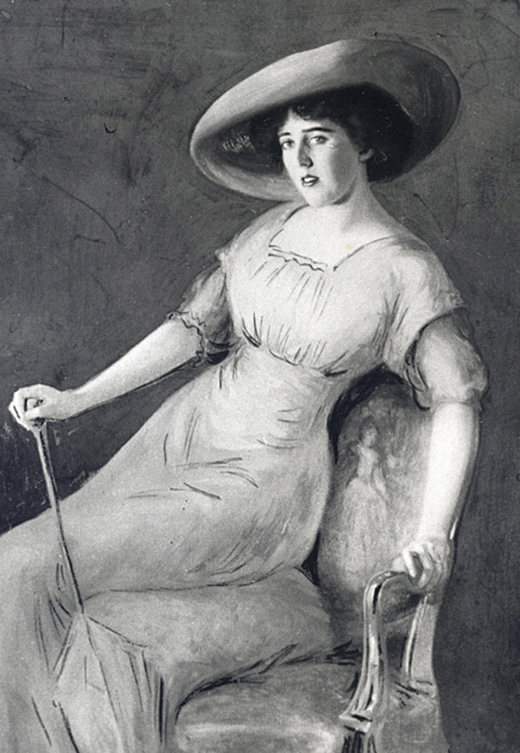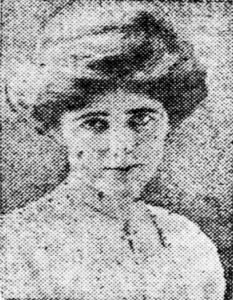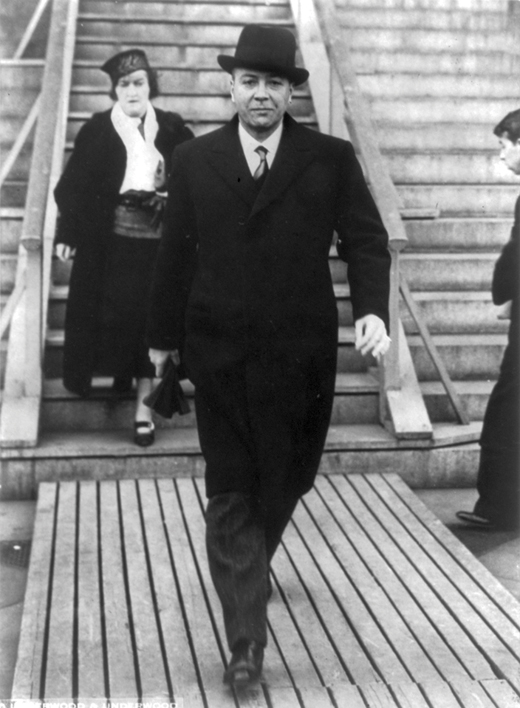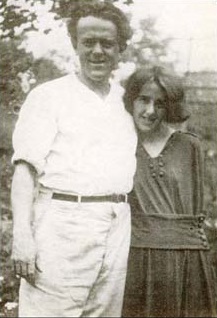It took a movie, 1981’s Reds, to both lift Louise Bryant from obscurity and reduce her to the sniveling acolyte of American communist John Reed, Annie Hall in a babushka. Wrong. For all her (many) faults, Louise Bryant was always her own woman – a fearless journalist, activist, suffragette, and talented writer. She was also reckless, with a compulsive need to court danger, and a study in contradictions – a chronic dissembler who sought the truth, a free love disciple who threw fits of jealousy, a communist who twice married rich men, and a feminist who was a serial seducer. Fiercely romantic, she always wanted to have a life of drama, tragedy, fascinating people and great events. She got her wish.
Louise’s father, Hugh J. Mohan, was a first-generation Irish journalist, orator and, befitting his convivial personality, traveling toastmaster. The Mohan family records were destroyed in the San Francisco earthquake, a fortuitous event for Louise, ever sensitive about her age. After Hugh took off (or, as Louise claimed, “died”), her mother married railroad worker Sheridan Bryant, allowing Louise to take her stepfather’s name and continue to fudge her birth date. She fudged other facts too, claiming at various times she was a relative of Oscar Wilde or the granddaughter of an Irish lord.
She moved to Portland, Oregon, and, always a free spirit, Louise lived on a houseboat where she entertained friends including wealthy dentist Paul Trullinger, known for his good humor and largesse with laughing gas. Enamored by her Bohemian style and beauty – “slender with vividly pretty Irish features, reddish-brown hair…heart-shaped face” Trullinger proposed, promising Louise she could keep her maiden name, continue her suffrage activism, and have a private studio to write and paint. It was 1909.

By 1915, Louise was a star in Portland but, getting restless living a bourgeois life married to, of all things, a dentist. Even the laughing gas parties had become a bore. But her life changed forever when she met John Reed, a war correspondent and committed radical who was in Portland visiting his family. The attraction was mutual, instant, and intense. Jack’s boyish energy, infectious idealism, and burly physique belied his delicate health and chronic kidney problem. He was not without contradictions either: a Harvard classmate said, quite truthfully, he was as “American as apple pie” – a description that later carried some irony when Jack became the first American to be buried at the foot of the Kremlin Wall.
After falling in love with Louise, Jack wrote a friend, “I have found her at last. She’s two years younger… wild and brave and straight, and graceful and lovely to look at.” Louise was indeed “lovely,” but actually two years older, something Jack never discovered thanks to the San Francisco earthquake. In short order, Louise dumped the dentist and moved to Greenwich Village to be with Jack.
Greenwich Village in the period before World War I was the center of the arts, leftist politics and sexual liberation, as close as America got to the Left Bank. Reed’s circle of friends was composed of radicals like him who looked with disdain on the “Uptowners,” the moralists north of 14th Street. They looked with disdain too on the newly arrived Louise Bryant; her beauty led all to assume she was vapid and unintelligent, one friend sniping, “Jack’s found himself a willing colleen.” But leave it to a profoundly homely anarchist, Emma Goldman, to come up with the real zinger, “I do wish sometimes I were as shallow as a Louise Bryant; everything would be so simple.”
Almost overnight the darling of Portland became the dud of Greenwich Village.
In time Louise found her voice, a modicum of acceptance and a few friends who realized she was more than a shallow colleen. A peripheral figure on the scene was the morose, alcoholic Eugene O’Neill who arrived after a stay at a tuberculosis sanitarium and an unsuccessful suicide attempt. Jack was particularly generous to him, urging O’Neill, who preferred the company of vagrants and sailors, to join the “Social Register of Greenwich Village Bohemia” as they wended their way to Provincetown Massachusetts in the summer of 1916. Louise was later to write of that time, “Never were so many people in America who wrote or painted or acted ever thrown together in one place.”
The Provincetown Players were a visionary theatre group, the first to recognize O’Neill’s genius and staged his one-act play Bound East for Cardiff. During the production O’Neill fell hopelessly in love with Louise but, out of loyalty to Jack, kept his feelings to himself. It was left to Louise to make the first move, sending him a note that suggested urgency, “I must see you alone.” They met, and in this small fishing village Louise came up with quite a fish tale – Jack, she confided to O’Neill, was too ill for a sexual relationship, his kidney and all that. He believed her, free love and all that, and they began their affair, one that everyone in the tight-knit community (saving Jack Reed) knew about. It was a classic love triangle, a theme that first appeared in the playwright’s Strange Interlude and would continue to reappear throughout his work.
On their return to New York, O’Neill stayed with the theatre company but was heartbroken when Jack and Louise headed upstate and married. Marriage might be a bourgeois convention, but Jack felt it a necessary one, since he was having kidney surgery and wanted to protect Louise if he died. He recovered, but his convalescence in Baltimore was prolonged, leaving Louise the opportunity to reunite with O’Neill. Free love got even more complicated after Jack’s return, when she found him in bed with the poet Edna St. Vincent Millay. Hardly the longsuffering, faithful wife, Louise nonetheless ran out of the house in hysterics and didn’t speak to Jack for months.
But when it seemed the United States might enter World War I, Jack and Louise focused and jilted, respectively, the poet and the playwright. Together they traveled the country, speaking out against a war that would have the working man fight and die for capitalists. When their country did enter the war in 1917, the couple turned to the revolution fomenting in Russia; this would be their chance to see the proletariat rise up.
As soon as Louise and Jack arrived in Russia in 1917, they seemed to be always in the right place at the right time, witnessing one of the most important events of the 20th century. They were there on October 23, 1917, when Lenin secretly entered Petrograd to lead the Bolshevik overthrow of the provisional government. Reed’s reportage became his book, Ten Days That Shook the World, a classic still read today. The kid from Oregon made no secret of his advocacy for the new Russia, “They no longer needed priests to pray them into heaven. On earth they were building a kingdom brighter than any heaven had to offer.”

Louise, originally charged with giving “the woman’s angle” to the Revolution, outgrew that assignment, giving a first-hand account of action, including getting shot at and almost killed. She interviewed all the key players, including Lenin and Trotsky, for her book, Six Red Months in Russia. Her writing is vivid and powerful, Trotsky has a personality “like Marat, vehement and serpent-like” and Lenin is “monotonous and dogged…with absolute moral indifference.”
Jack needed to remain in the Soviet Union, so Louise returned to New York alone, now a recognized Russian authority, and an instant celebrity on the lecture circuit. Inspired by the liberated women she saw in Russia, she used her new fame to again lead suffrage protests, even landing in a Washington jail. Her vanity, never tiny, was now amped up, emboldening her to contact O’Neill, now in a relationship with Louise-lookalike, Alice Boulton. Once again Louise wrote saying she “must see” him, claiming she had just tromped thousands of miles of frozen terrain to be with him and would even forgive him for being with “some girl in the Village.”
O’Neill, sorely tempted by his long-term temptress, wisely declined. No matter, Louise moved on knowing Jack at last was on his way home. But once he landed in New York, Jack was arrested for violating the Espionage Act and forbidden to leave America. This was a problem: he needed to return to Russia to get their support for the American Communist party.
No less a personage then James Larkin, Irish Republican and socialist, who was in New York, stepped in. Larkin got Reed forged papers and smuggled him out of the country on a Swedish freighter. But as soon as Jack arrived in Finland, he was put in prison on the orders of a party operative, the shifty Grigory Zinoviev. When Louise got word that Jack was freezing and starving in a Finnish jail, she was determined to get to him. Finally, after months of really tromping through frozen terrain, she found him, “sadder and older” (he was 32). It was 1920 and they were both disillusioned with the Revolution, disgusted with the Bolsheviks’ lust for power, and saw the leaders as dictators and executioners. Both wondered if they had been played – were they a pair of what Lenin would call “useful idiots”?
Louise was by his side when Jack, much reduced by a year of imprisonment, died of typhus in 1920, a few days short of his 33rd birthday. Despite his recent treatment by the authorities, Jack’s funeral was one of pageantry; the Russians now claimed him as a mythic figure in their history. His widow was front and center until she fainted and was hospitalized – Louise had gotten all the drama she had dreamt about as a young girl.
The third act of Louise’s life started well. She traveled throughout Europe as a foreign correspondent for William Randolph Hearst and it was in Paris she met William C. Bullitt of Philadelphia, a millionaire and former diplomat. Bullitt, as men do, fell madly in love with Louise, pursued her across Europe and finally off-loaded his socialite wife. Much like Louise scandalized Portland in 1916, she and Bullitt were the talk of Paris when they married in 1923. Again, playing the San Francisco earthquake card, she told Bullitt she was 29 when she was actually 38. The communist was soon living the life of a rich man’s wife in Paris and gave birth to a daughter, Anne Moen Bullitt, the “Moen” a tribute to her long-forgotten maiden name, Mohan.

Janet Flanner of the New Yorker introduced Louise to the lesbian subculture of the Left Bank – Sylvia Beach, Gertrude Stein and sculptor, Gwen Le Gallienne, with whom Louise began an affair. Then, almost as if she were paying for her sins, however venial, Louise developed a rare and disfiguring disease, Adiposis dolorosa. The disease caused fatty tumors to develop under her skin; there was no cure but much suffering and Louise, never much of a drinker, turned to absinthe – and lots of it – to ease her pain. The gross Adiposis, the alcoholism and the lesbian affair were all too much for Bullitt, who divorced Louise, gaining custody of Anne.
Bullitt took Anne to Ireland, where she was to spend most of her childhood while Louise kept trying and failing to get news of her daughter. (The news her mother never heard was that Anne Moen Bullitt lived out her life on a 700-acre estate in County Kildare, where she became one of Ireland’s first female horse breeders.)
Janet Flanner once offered a horrifying picture of Louise’s last days: “It was a rainy night when I was walking along Rue Vavin in Montparnasse. Literally out of the gutter rose a terrifying creature. Her face was so warped I didn’t recognize her.” Louise died penniless in a $2-a-night hotel in 1936. She was 50 (really).
Somerset Maugham fictionalized her downfall in The Razor’s Edge, where she was “Sophie,” an addicted American expatriate who descended into drugs and promiscuity. Her biographer, Mary Dearborn, offers a newer, revisionist take, seeing Louise as a true 20th-century heroine, her place in history stolen by “gender politics” and a vindictive ex-husband, Bullitt, who warehoused her papers in a Dublin basement. But the last word should go to Eugene O’Neill, who knew her best. Hearing of her death, he said she was “a great woman, something out of the old Irish legends, betrayed by life.” ♦
_______________
Rosemary Rogers co-authored, with Sean Kelly, the best-selling humor / reference book Saints Preserve Us! Everything You Need to Know About Every Saint You’ll Ever Need (Random House, 1993), currently in its 18th international printing. The duo collaborated on four other books for Random House and calendars for Barnes & Noble. Rogers co-wrote two info / entertainment books for St. Martin’s Press. She is currently co- writing a book on empires for City Light Publishing.


Great article. I have been reading a lot of Eugene O’Neill lately.There is a one act play The Personal Equation that clearly has the theme of a woman revolutionary and her being a temptress of a son of a captain of industry.
Thinking the Louise must have been the inspiration.